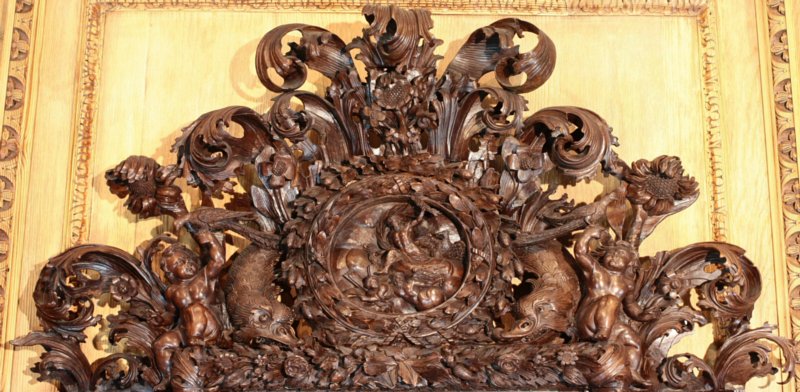Dalva Brothers Antiques, Antique Furniture, New YorkFrench 18th century furniture, clocks, lighting, paintings, porcelain, sculpture and tapestries |
| Magnificent Italian baroque reticulated walnut mirror, The Four Elements, composed of large acanthus scrolls that contain putti, birds, dolphins, sunflowers and other floral motifs. These enclose four smaller scale mythological reserves symbolizing the four elements designed by Simon Vouet as engraved by Michel Dorigny. The carving is attributed to Maestro Giuseppe. (Air) Jupiter with his attributes—an eagle and thunderbolts—towers in the clouds above a winged god wearing a crown and holding a wand, and a winged goddess, probably symbolizing the winds. A print by Michel Dorigny after a Simon Vouet painting created for the Vestibule de la Reine at Fontainebleau is the source of the carving. (Earth) Apollo slays the Python at Delphi with his bow and arrow. The lair of the Python was considered the center of the Earth. (Water) Neptune, with the reluctant Amphitrite, is in his shell-form vessel that is being pulled by hippocampi. The original painting by Vouet for this composition was also at Fontainebleau. (Fire) Hercules slays the Lernean Hydra, while his companion, Iolaus, cauterizes the wounds with a torch to prevent the heads’ resprouting. . The roundels are framed with flowers and leafage containing acorns – a symbol of power and antiquity. They are enlivened with naturalistic groupings of birds cavorting in the foliage; there is also a snake crawling under a ribbon that binds the garland under the mirror glass. There are three “Green Man” foliate masks – a large one at the bottom of the frame holding oak sprigs with acorns in his mouth, and two smaller ones facing inwards at the sides of the Hercules and Apollo roundels. The roundels’ four elements mythological symbolism is continued in the surrounds, but here with naturalistic symbolism: the birds symbolize air; the plants, Green Men, and the snake earth; the dolphins water; and for fire, the unusual downcast sunflowers, which normally face the blazing sun - as well as the two putti who are protecting themselves from the sun’s flaming heat and light with arms that become acanthus sunshades – possibly an invention unique to this mirror. The baroque penchant for theatricality is demonstrated by the way the putti are realistically integrated into the composition: the pair at the base are supporting the mirror’s rectangular frame on their backs; the pair higher up are balancing the Hercules and Apollo roundels on their shoulders; the pair shielding themselves actually become the acanthus scrolls that are the primary organizing element of the overall composition; and the highest pair are sitting on the mirror’s upper frame with on leg dangling while holding aloft large birds. The Hercules reserve is signed: “GIVSEP. AVP. Fc” The Apollo reserve is signed: “AV. F.” [All the groups of letters have tildes above – indicating unwritten letters, a scribal abbreviation that was used as a "mark of suspension."] “Maestro Giuseppe” was Wood Carver to the Duke of Parma at the period the mirror was made. Only a virtuoso craftsman would have been both awarded the title “Maestro” and have been famous enough to be known by his first name – in the same way Michelangelo, Leonardo and Elvis are known by theirs. Italian scholars of the decorative arts have long searched for his identity. It is well known that he was a teacher of Andrea Fantoni, who became one of the most illustrious wood carvers of the 17th century. That the eminent Fantoni dynasty of wood carvers would send their most promising scion to Parma for training by Maestro Giuseppe is proof of his esteem at the time. Since it is so unusual for an Italian baroque decorative arts piece to be signed, one wonders if the artist was requested to sign it because he had so successfully completed what must have been an enormous commission and difficult undertaking. It is certain that someone called Giuseppe was the sculptor of this masterpiece, and to sign such a piece in such a manner, the maker must have been well known. Since Maestro Giuseppe apparently is the only wood carver called Giuseppe with that sort of name recognition, it seems logical to assume that Maestro Giuseppe was the sculptor, especially since the mirror bears stylistic similarities with work from his region in his period. It is possible that “AVP”, or “AUP” (in a sculptural convention, a “V” can be either a “V” or a “U” – as in “GIVSEP”), as well as the “AV”, are letters from Giuseppe’s lost last name; it is also possible they are letters associated with the name of another artist who might have designed the elaborate composition with borrowed imagery from Simon Vouet and Michel Dorigny. [Mirror glass replaced. Small repairs.] For a more complete description and analysis of this extraordinary piece, please go to Essays |
||
| Height (ins.): 82 (208.3cm) Length/Width (ins.): 57 (144.8cm) | ||
| Origin: Italy, possibly Parma or Brescia, 17th century Period: Baroque | ||
|
|
||
|
||
| << Previous Page | ||




